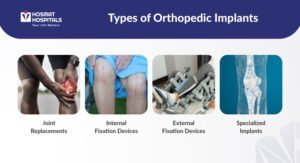
Orthopedic implants provide solutions to various musculoskeletal injuries and conditions, revolutionizing orthopedic surgery. These implants, ranging from screws and plates to joint replacements, play a crucial role in restoring mobility, alleviating pain, and improving quality of life for millions of patients worldwide. However, understanding the different types of Orthopedic implants, their associated risks and their benefits is essential for both patients and healthcare professionals. In this blog post, we delve into the world of orthopedic implants to provide a comprehensive overview.
Introduction
Orthopedic implants are medical devices designed to replace or provide support to damaged bones or joints, enhancing the quality of life for individuals suffering from orthopedic conditions. These implants not only promise a return to mobility but also offer a beacon of hope for pain relief and a better quality of life. However, as with any medical intervention, they come with their own set of risks and considerations.
Types of Orthopedic Implants
Joint Replacements
Joint replacements are among the most common and successful orthopedic surgeries, aimed at alleviating pain and restoring function in severely damaged joints.
-
Hip Replacements
These involve replacing both the ball and socket of the hip joint with artificial components, typically made from metal, ceramic, or plastic materials.
-
Knee Replacements
A knee replacement involves the replacement of the damaged surfaces of the knee joint with artificial parts to relieve pain and improve mobility.
-
Shoulder Replacements
Similar to hip and knee replacements, but less common, shoulder replacements involve replacing the damaged joint surfaces with artificial ones.
Internal Fixation Devices
These devices are used to hold broken bones in place, facilitating proper healing.
-
Screws and Plates
Metal plates and screws are commonly used to stabilize fractured bones.
-
Nails and Rods
Long bones like femurs are often repaired using metal rods inserted into the marrow canal.
-
Wires and Pins
Smaller bones or more intricate fractures might be fixed using wires and pins for stability.
External Fixation Devices
External fixators are used to stabilize fractures from outside the body, often as a temporary solution before internal fixation or in cases where internal fixation is not viable.
-
External Fixators
These involve a scaffold-like frame attached to the bone through pins, holding bones in place externally.
-
Halo Vest Devices
Primarily used in neck fractures or cervical spine injuries, it secures the head in place relative to the rest of the body.
-
Ilizarov Apparatus
A specialized form of external fixator used for complex or long-bone fractures, it also facilitates bone lengthening.
Specialized Implants
Besides the common types, there are specialized implants catering to specific needs.
-
Spinal Implants
These are used to treat various conditions of the spine, including deformities, and instabilities, and as support post-surgery.
-
Dental Implants
A boon in cosmetic and restorative dentistry, these replace missing teeth, providing a functional and aesthetic solution.
-
Custom Implants
Tailored to the patient’s specific anatomy, these are used in cases where standard implants may not be suitable.
Benefits of Orthopedic Implants:
-
Pain Relief
Implants can significantly reduce pain associated with musculoskeletal conditions and injuries, improving overall quality of life.
-
Restored Function
Joint replacements and stabilization devices restore mobility and function, allowing patients to resume daily activities.
-
Faster Healing
Internal fixation devices promote bone healing by providing stability and support, leading to quicker recovery times.
-
Improved Quality of Life
For patients with severe arthritis or debilitating injuries, orthopedic implants offer the opportunity to regain independence and mobility.
-
Long-Term Success
With advancements in implant materials and surgical techniques, many orthopedic implants have excellent long-term success rates.
Risks Associated With Orthopedic Implants:
-
Infection
Implant-associated infections can occur during or after surgery, leading to serious complications and implant failure.
-
Implant Failure
Mechanical failure, loosening, or displacement of implants may necessitate revision surgery.
-
Implant Allergy
Some patients may experience allergic reactions to implant materials, although rare.
Conclusion
Orthopedic implants have revolutionized the treatment of musculoskeletal disorders, offering effective solutions for joint pain, fractures, and spinal conditions. However, it’s essential for patients to understand the types, risks, and benefits associated with these implants to make informed decisions about their orthopedic care. By working closely with their orthopedic surgeon and following postoperative instructions, patients can achieve optimal outcomes and regain their mobility and quality of life.
At Hosmat Hospitals, the best orthopedic hospital in Bangalore, our team of experienced orthopedic surgeons is dedicated to providing personalized care and innovative treatment options for patients in need of orthopedic interventions. If you or a loved one is considering orthopedic implant surgery, we invite you to schedule a consultation with one of our specialists to learn more about your options for getting better health. Contact us today to schedule an appointment. Getting better orthopedic health starts here.
Disclaimer: This blog is intended for educational purposes only and should not be interpreted as medical advice. For any health concerns or medical questions, please consult your healthcare provider. The information provided here is not a substitute for professional medical guidance, diagnosis, or treatment.


